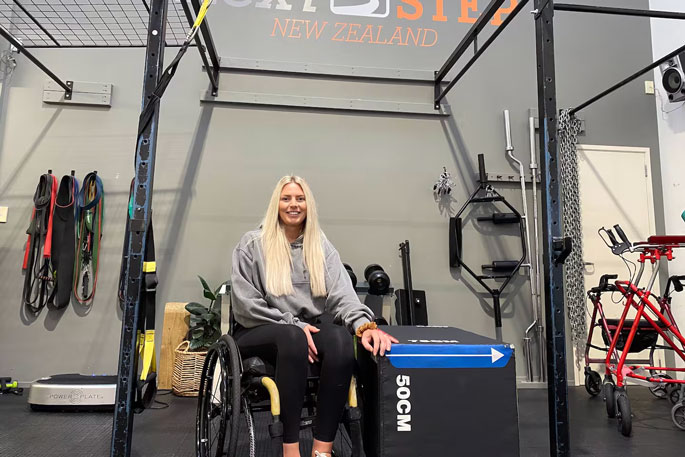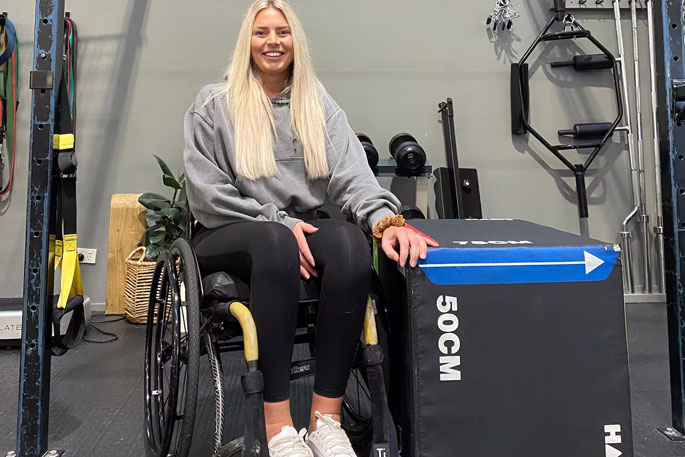Bay of Plenty gym owner Casey Brady is “determined” to walk again.
The 31-year-old was left paralysed from her lower chest down after a motocross accident in Taupō in June 2017.
Due to a spinal cord injury, specialists told Brady she would never walk again.
She wants to prove them wrong.
“I’m never going to accept it, as such.”
Since the accident, Casey has done a lot of “intensive” rehabilitation, bought a gym, retrained as a personal trainer, travelled to the US for stem cell treatment.
If that's not enough motivation to keep trying to beat the odds, she is expecting her first child via a surrogate next month and aims to give her daughter “every opportunity”.
“As s*** as my accident was, I’ve found my purpose. And I love it.”
‘I’d never felt like that before’
Speaking to the Bay of Plenty Times from her business NextStep New Zealand in Mount Maunganui, Casey says she started motocross riding when she was 12 after her parents bought a farm in Pyes Pa.
Her father built a motocross track at home and she and her three sisters enjoyed riding.
On the day of the accident, Casey says she went over a jump, flew over the handlebars, landed on her head, and knocked herself out.
“When I came around, I felt my tummy and it was a really weird feeling. I just knew it was serious. I didn’t move – I’d never felt like that before.”
She remembered the paramedic telling her a helicopter was on the way.
“I don’t really remember much after that.”
Casey was airlifted to Middlemore Hospital where she had surgery for her spinal cord injury.
“I broke my back at T6 [vertebrae].”
After a week in hospital, she spent three months in a spinal ward in Auckland doing rehabilitation and learning how to sit up, move, use a wheelchair and drive again.
‘I needed a purpose’
After being discharged, Casey - who lives with her husband Mitch in Te Puke - stayed with family while their home was renovated to make it more accessible and wheelchair-friendly for her.
She says they needed ramps, “roll-in” showers and bigger bathrooms. They also made a lower bench and sink in the scullery that Casey could roll under.
“I'm determined to walk again … I do heaps of intensive rehab.”
This includes locomotor training – walking in a harness on a treadmill – acupuncture, electrical stimulation, using a hyperbaric chamber and swimming.
“You name it, I try it.”
Pre-accident, Casey was a preschool teacher. Afterwards, she and a business partner bought the NextStep New Zealand franchise and she did a personal training course.
“I needed a purpose.”
 NextStep New Zealand co-owner and director Casey Brady. Photo / Megan Wilson.
NextStep New Zealand co-owner and director Casey Brady. Photo / Megan Wilson.
NextStep has gyms in Mount Maunganui and Whakatāne.
It is accessible to everyone and helps people with neurological rehabilitation such as those who have had strokes, Parkinson’s disease and spinal cord injuries, she says.
Casey says being treated as a “normal person” by family and friends helps her stay positive.
“I think having an amazing trainer and a purpose … I’ve made my life around my goal. My rehab is part of my work.
“That’s made a massive difference. If I had to go back to teaching, I don’t know how I’d fit in my rehab and that would upset me.”
She says the hardest part about using a wheelchair is feeling angry: “I just want to stand up and reach something or help someone.
“[But] being miserable … doesn’t get you anywhere.”
“I definitely get sad and over it … I have heaps of pain.”
She describes experiencing nerve pain as “like I’m in a vice in a fire with pins and needles”.
Casey says she did not have nerve pain initially after her accident, so she believes it's a good sign that feeling is returning.
‘Teaching your body to learn to walk again’
Casey went to Florida in the US for stem cell treatment last month.
She explains it involves umbilical stem cells being administered intravenously into her spinal cord where her injury is and her lower back.
Casey says stem cell treatment is not a cure but will go hand-in-hand with intensive rehabilitation.
 Casey Brady does about 30 hours of rehabilitation per week. Photo / Megan Wilson.
Casey Brady does about 30 hours of rehabilitation per week. Photo / Megan Wilson.
“You’re teaching your body to learn to walk again or to find those signals so hopefully that will just clear more of the pathway.
“I’d come home and do heaps of rehab and then my body would use those stem cells to create a new pattern … rather than my stem cells that I had in that area which were damaged.”
Casey expects it will take three months to notice a difference.
After one month: “I think something’s happening”.
Becoming a mother a ‘life dream’
Casey says her injury means she's “high risk” to carry a baby. She also has a blood condition that would impact the baby getting iron.
She and Mitch decided to explore surrogacy as an option.
She says they used a fertility clinic and found their surrogate via social media.
“I met the most amazing human that is carrying my baby.”
Casey says her daughter is due at the end of August.
Casey and Mitch had been together since she was 18. They would have started trying for a baby soon about the time she had her accident had she not been injured.
“I have nieces and nephews … I love being around them so I can’t wait.”
She says she wants to be able to walk for her baby so she can enjoy time with her and “give her every opportunity”.
“Kick a ball, play at a playground with her, take her to the beach.”
Casey says beaches and playgrounds are, in her experience, generally very inaccessible and she hates the idea of not being able to take her daughter “to do normal things other kids get to do with their mums”.



0 comments
Leave a Comment
You must be logged in to make a comment.